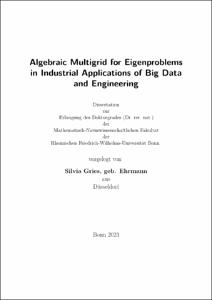Gries, Silvia: Algebraic Multigrid for Eigenproblems in Industrial Applications of Big Data and Engineering. - Bonn, 2023. - Dissertation, Rheinische Friedrich-Wilhelms-Universität Bonn.
Online-Ausgabe in bonndoc: https://nbn-resolving.org/urn:nbn:de:hbz:5-73191
Online-Ausgabe in bonndoc: https://nbn-resolving.org/urn:nbn:de:hbz:5-73191
@phdthesis{handle:20.500.11811/11197,
urn: https://nbn-resolving.org/urn:nbn:de:hbz:5-73191,
doi: https://doi.org/10.48565/bonndoc-187,
author = {{Silvia Gries}},
title = {Algebraic Multigrid for Eigenproblems in Industrial Applications of Big Data and Engineering},
school = {Rheinische Friedrich-Wilhelms-Universität Bonn},
year = 2023,
month = dec,
note = {More and more data are generated and gathered by computational simulations, network evaluations, and sensor usage in industrial applications and many other methods. To make the most out of the collected data, these should be examined in search of (hidden) patterns or any other predictive information. This analysis gives rise to sparse linear systems and the need to calculate the smallest eigensolutions of them.
To evaluate these data, matrices via Graph Laplacian or adjacency graphs are defined and the corresponding eigenproblems need to be solved. These matrices mainly have a sparse pattern. However, a few rows do not fit in this pattern. They are connected to more data points. This inhomogeneous pattern is difficult for most linear solvers. This also holds for classical Algebraic Multigrid (AMG), although it should generally be well-suited for these systems. It should be promising as it has excellent scaling properties and is only relying on algebraic information.
AMG, similar to other iterative linear solvers, is a two-phase algorithm. At first, a setup is constructed. This is then used for the solution. In this thesis, we are modifying both phases of the AMG solver in order to apply it to data science problems.
We are introducing a new approach for the setup of AMG that can especially handle the matrix inhomogeneities. Based on this, we will develop an approach to solve (modified) eigenproblems by exploiting the AMG hierarchy for problems as they arise in data analysis.
We demonstrate the applicability of these both methods with various examples. In the first instance, we take the Poisson problem to show the effect of algorithmic variations we implemented. The setup approach is additionally evaluated for petroleum reservoir simulations and different Graph Laplacians. We use the eigensolution calculation also for Graph Laplacians. However, we additionally improve the solution for very ill-conditioned problems from structural mechanics.},
url = {https://hdl.handle.net/20.500.11811/11197}
}
urn: https://nbn-resolving.org/urn:nbn:de:hbz:5-73191,
doi: https://doi.org/10.48565/bonndoc-187,
author = {{Silvia Gries}},
title = {Algebraic Multigrid for Eigenproblems in Industrial Applications of Big Data and Engineering},
school = {Rheinische Friedrich-Wilhelms-Universität Bonn},
year = 2023,
month = dec,
note = {More and more data are generated and gathered by computational simulations, network evaluations, and sensor usage in industrial applications and many other methods. To make the most out of the collected data, these should be examined in search of (hidden) patterns or any other predictive information. This analysis gives rise to sparse linear systems and the need to calculate the smallest eigensolutions of them.
To evaluate these data, matrices via Graph Laplacian or adjacency graphs are defined and the corresponding eigenproblems need to be solved. These matrices mainly have a sparse pattern. However, a few rows do not fit in this pattern. They are connected to more data points. This inhomogeneous pattern is difficult for most linear solvers. This also holds for classical Algebraic Multigrid (AMG), although it should generally be well-suited for these systems. It should be promising as it has excellent scaling properties and is only relying on algebraic information.
AMG, similar to other iterative linear solvers, is a two-phase algorithm. At first, a setup is constructed. This is then used for the solution. In this thesis, we are modifying both phases of the AMG solver in order to apply it to data science problems.
We are introducing a new approach for the setup of AMG that can especially handle the matrix inhomogeneities. Based on this, we will develop an approach to solve (modified) eigenproblems by exploiting the AMG hierarchy for problems as they arise in data analysis.
We demonstrate the applicability of these both methods with various examples. In the first instance, we take the Poisson problem to show the effect of algorithmic variations we implemented. The setup approach is additionally evaluated for petroleum reservoir simulations and different Graph Laplacians. We use the eigensolution calculation also for Graph Laplacians. However, we additionally improve the solution for very ill-conditioned problems from structural mechanics.},
url = {https://hdl.handle.net/20.500.11811/11197}
}






